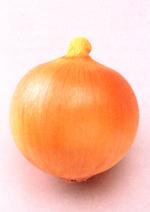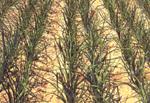| Fruits |
Vegetables
|
Onion, Allium cepa / Liliaceae (Alliaceae)
|
Note: Composition for 100 g. of fresh product Values in ( min. - max. ) format. | |
| Energy: 21.00-36.00 kcal Fats: 0.20-0.25 g Fibres: 1.40-1.81 g Fat Acids Polyunsat.: 0.10-0.10 gMinerals Calcium: 25.00-31.00 mgZinc: 0.200-0.270 mg Chlorine: 25.00-25.00 mg Phosporus: 30.00-42.00 mg Iron: 0.300-0.500 mg Magnesium: 4.00-12.00 mg Manganese: 0.084-0.182 mg Potasium: 135.00-210.00 mg Selenium: 1.00-1.47 µg Sodium: 3.00-20.00 mg Iodine: 2.09-4.80 µg | Proteins: 0.90-1.25 kcal Carbohidrates: 3.80-7.90 g Liposoluble Vitamins A Retinol: 0.00-1.15 µgA Carotenoids: 6.90-10.00 µg E or Tocoferol: 0.267-0.31 mg Liposoluble Vitamins B1 or Thiamine: 0.023-0.130 mgB2 or Riboflavine: 0.010-0.020 mg B3 or Niacine: 0.60-0.70 mg B5 or Pantothenic Acid: 0.110-0.170 mg B6 or Piridoxine: 0.152-0.20 mg B9 or Folic Acid: 5.00-8.00 mg C or Ascorbic Acid: 5.00-8.00 mg |
|
Note: Composition for 100 g. of fresh product Values in ( min. - max. ) format. | |
| Energy: 17.00-17.00 kcal Fats: 0.20-0.20 g Fibres: 0.70-0.70 g Minerals Calcium: 19.00-19.00 mgZinc: 0.20-0.20 mg Chlorine: 6.00-6.00 mg Phosporus: 16.00-16.00 mg Iron: 0.30-0.30 mg Magnesium: 3.00-3.00 mg Potasium: 90.00-90.00 mg Sodium: 2.00-2.00 mg Iodine: 1.00-1.00 µg | Proteins: 1.20-1.20 kcal Carbohidrates: 3.70-3.70 g Liposoluble Vitamins A Retinol: 0.00-0.00 µgA Carotenoids: 5.00-5.00 µg E or Tocoferol: 0.15-0.15 mg Liposoluble Vitamins B1 or Thiamine: 0.09-0.09 mgB3 or Niacine: 0.30-0.30 mg B5 or Pantothenic Acid: 0.07-0.07 mg B6 or Piridoxine: 0.12-0.12 mg B9 or Folic Acid: 3.00-3.00 mg C or Ascorbic Acid: 3.00-3.00 mg |

The onion is an underground, eadible bulb that grows in the plant that bears the same name. It is a vegetable of Asian origin cultivated since 6,000 B.C. From Asia it spreaded to Europe, and from there to America. At the moment, there is a wide range of varieties, that can be classified according to the colour of the bulb, the shape, size, use, origin and earliness. It is used in many ways for cooking, both raw and cooked. Moreover, it has various medicinal properties.
Nutrition and eating
The onion has been used for a long time as a medicinal plant; that is why there exist many prescriptions and remedies for different aches and pathologies. It is used in many ways, in juice, tinctures, wine, poultice, infusion or roasted.
The fruit
 The onion is an underground, eadible bulb that grows in the plant that bears the same name. It is a vegetable of Asian origin cultivated since 6,000 B.C. From Asia it spreaded to Europe, and from there to America. At the moment, there is a wide range of varieties, that can be classified according to the colour of the bulb, the shape, size, use, origin and earliness. It is used in many ways for cooking, both raw and cooked. Moreover, it has various medicinal properties.
The onion is an underground, eadible bulb that grows in the plant that bears the same name. It is a vegetable of Asian origin cultivated since 6,000 B.C. From Asia it spreaded to Europe, and from there to America. At the moment, there is a wide range of varieties, that can be classified according to the colour of the bulb, the shape, size, use, origin and earliness. It is used in many ways for cooking, both raw and cooked. Moreover, it has various medicinal properties.The onion belongs to the Liliaceous family; its scientific name is Allium cepa. It is one of the eldest cultures known; the Simerian civilization, in 6,000 B.C., already knew it. Its origin is located in Iran and Pakistan.
The onion is a tunic bulb, which means that it is formed by several layers, as we can see if we cut it. These layers are concentrical succulent leaves. They can have different shapes, sizes and colours, ranging from white to red and yellow.
There are many onion varieties, classified in different types. They may be graded according to their use, flavour, colour, shape or earliness.
The onion is consumed raw, fried, boiled and roasted, almost always as garnish. Several by-products are also used: dehydrated or the food nutritional industry as seasoning in various foodstuffs; the onion powder is used to make onion salt; the onion oil is diluted in vegetal oil or capsulized. There are also tinned and bottled onions, frozen onion rings and pickled onions. Tender onions are marketed fresh or in bunches.
From the very old times, medicinal properties have been given to the onion. Its contents in minerals and vitamins is relatively low, but it is rich in essential oils containing sulphur. There are multiple benefits conferring this vegetable, among which are the following: it is bacteriostatic, it activates the bile secretion, it stimulates the intestine’s digestive activity, it lowers the blood pressure, it helps to regenerate blood in case of serious anemia, it is diurtic, expectorant and an intestine disinfectant. It is useful to fight rhinitis, facial neuralgia, throat infections and pharyngitis, pain in the ears, colds and infectious diseases. Moreover, it is antiseptic, vermifugal and it reduces the level of glucose in blood.
The plant

The onion belongs to the Liliaceous family, Allium capa species. It is cultivated to consume the bulb developed underground. This organ consists of base of the plant’s leaves, that are suculent and concentrical. If it is kept one more year in the field, the plant bears a stem that sometimes reaches 1 meter with an inflorescence compunded of multiple small flowers.
The root system consists of a great number of white roots. In the base of the bulb there is a squashed mass known as disc, that corresponds with the stem. The leaves grow on this stem, formed by two different parts. The inferior part is called covering pod. The group of sheaths forms a swollen organ called tunic bulb, since it is surrounded by the swollen and succulent leaves bases; they are completely wrapped one on the top of the other. The outer leaves are in charge of protecting the bulb, and they acquire a dark colour. The upper part of the leaves is hollow, round and green.
During the second year, the disc bears a stem that will develop flowers on its tip. This stem may reach more than 1m high. The flowers are grouped in a globose or conical mass covered by a whitish membrane. This membrane torns, bearing an inflorescence in umbel with many flowers.
The seeds of the onion are black, round and slightly flat. There are approximately 250 seeds in a gram.
The root system consists of a great number of white roots. In the base of the bulb there is a squashed mass known as disc, that corresponds with the stem. The leaves grow on this stem, formed by two different parts. The inferior part is called covering pod. The group of sheaths forms a swollen organ called tunic bulb, since it is surrounded by the swollen and succulent leaves bases; they are completely wrapped one on the top of the other. The outer leaves are in charge of protecting the bulb, and they acquire a dark colour. The upper part of the leaves is hollow, round and green.
During the second year, the disc bears a stem that will develop flowers on its tip. This stem may reach more than 1m high. The flowers are grouped in a globose or conical mass covered by a whitish membrane. This membrane torns, bearing an inflorescence in umbel with many flowers.
The seeds of the onion are black, round and slightly flat. There are approximately 250 seeds in a gram.
Tricks and tips
Prevent your breath from smelling
Onions, eaten raw, have excellent diuretic properties. When cooked, it has laxative properties. But your breath can smell if eaten raw. In order to avoid this it is recommended to chew a pair of coffee beans
Softer onions
If you wish a softer flavour and texture, leave onions to soak in lemon juice
Stop crying
To avoid crying when peeling onions previously keep them in the freezer for about 15 minutes.
| Interempresas Media, S.L. / 2025 | [ Legal notice | Política de Protección de Datos | Política de cookies | Publicidad] |
